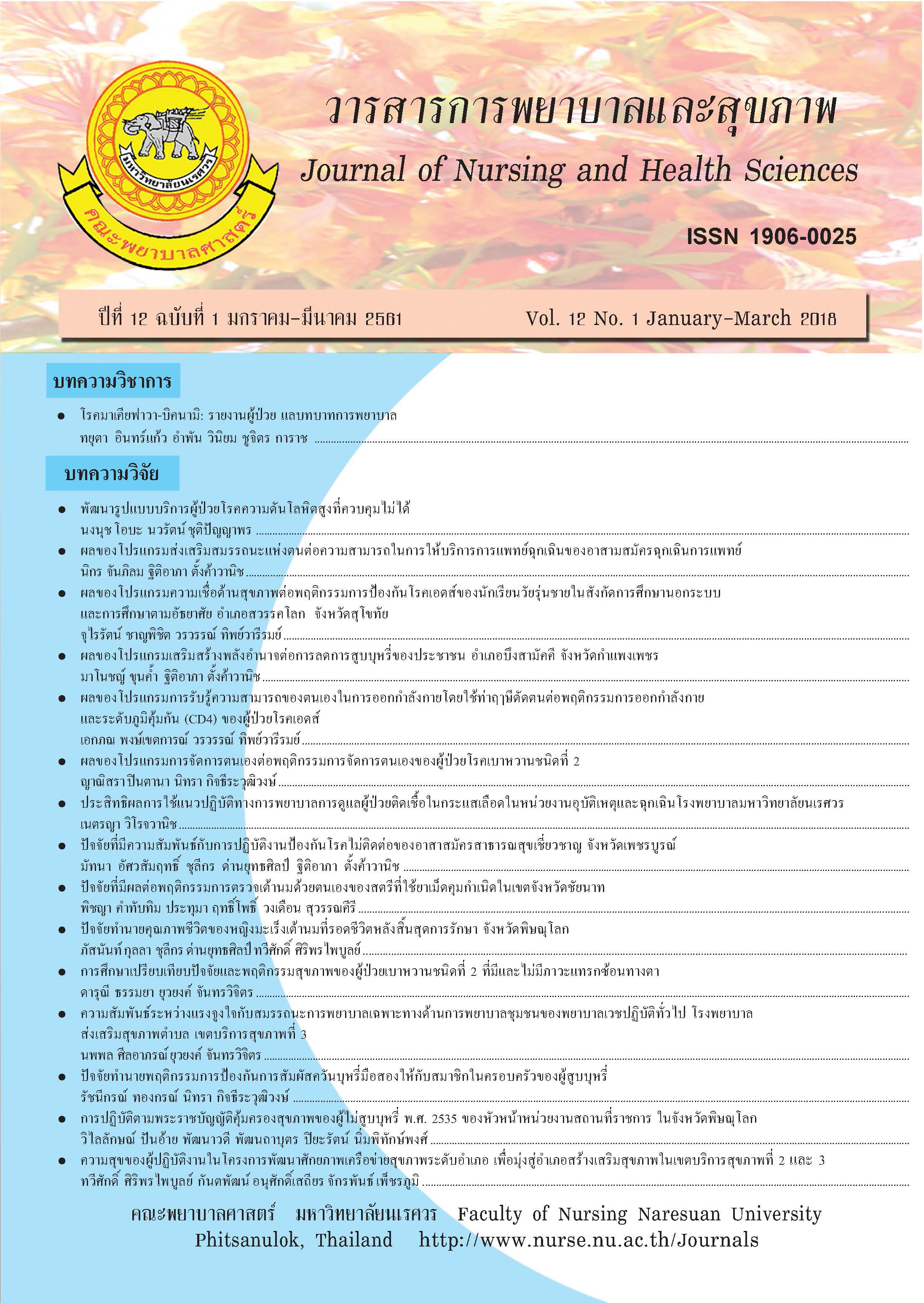โรคมาเคียฟาวา-บิคนามิ: รายงานผู้ป่วย และบทบาทการพยาบาล
Main Article Content
บทคัดย่อ
โรคมาเคียฟาวา-บิคนามิ (Marchiafava-Bignami) เป็นโรคเกี่ยวกับระบบประสาทพบได้ไม่บ่อยนัก และการวินิจฉัยโรคนี้ ต้องอาศัยการซักประวัติและการตรวจทางรังสีวิทยา พยาธิสภาพแสดงความจำเพาะ ที่สมองส่วนคอร์ปัส คาโลซัม และปัจจัยที่มีความสัมพันธ์กับการเกิดโรคนี้ ได้แก่ การดื่มสุรา การขาด วิตามินและสารอาหาร รายงานผู้ป่วยชายไทยอายุ 61 ปี มีประวัติการดื่มสุราเป็นระยะเวลายาวนาน อาการสำคัญคือ เรียกไม่รู้สึกตัว ระหว่างนอนโรงพยาบาลมีอาการชัก เอกซเรย์คอมพิวเตอร์สมอง พบความ ผิดปกติที่คอร์ปัส คาโลซัมมีความหนาแน่นลดลงตลอดความยาวของคอร์ปัส คาโลซัม และเนื้อสมองสีขาว (white matter) มีการเปลี่ยนแปลงเกิดขึ้นอย่างรุนแรง ผู้ป่วยเข้ารับการรักษาตัวในหอผู้ป่วยกึ่งวิกฤต หลังจากได้รับการรักษาด้วยวิตามินบี 1, บี 1, 6, 12, สเตียรอยด์ โฟลิคและยากันชักอาการจึงดีขึ้น และ ส่งตัวไปรับการรักษาต่อที่โรงพยาบาลใกล้บ้าน โดยพยาบาลมีบทบาทสำคัญในการดูแลผู้ป่วยระหว่างเข้ารับ การรักษาตัวในโรงพยาบาลและการเฝ้าระวังภาวะแทรกซ้อนที่อาจจะเกิดขึ้น นอกจากนี้ในรายที่รอดชีวิต พยาบาลควรคำนึงถึงการให้คำปรึกษาเรื่องการเลิกสุรา การฟื้นฟูสมรรถภาพ และการได้รับสารอาหาร เพื่อให้ผู้ป่วยมีคุณภาพชีวิตที่ดีขึ้นหลังจากการรอดชีวิตกลับไป
Article Details
เอกสารอ้างอิง
syndrome. วารสารสมาคมประสาทวิทยาศาสตร์
ภาคตะวันออกเฉียงเหนือ, 10(2), 80-91.
อรวรรณ ศิลปกิจ. (2556). โรคจิตจากโรคมาเคียฟาวา-
บิคนามิ. วารสารสุขภาพจิตแห่งประเทศไทย,
21(3). 198-208.
Boutboul, D., Lidove, O., Aguilar, C., Klein, I., & Papo,
T. (2010). Marchiafava-Bignami disease
เอกสารอ้างอิง
complicating SC hemoglobin disease and
Plasmodium falciparum infection. La Presse
Medicale, 39(9), 990-993.
Caulo, M., Briganti, C., Notturno, F., Committeri, G.,
Mattei, P. A., Tartaro, A., . . . & Uncini, A.
(2009). Non-alcoholic partially reversible
Marchiafava-Bignami disease: review and
relation with reversible Splenial lesions a case
report and literature review. The neuroradiology
journal, 22(1), 35-40.
Celik, Y., Temizoz, O., Genchellac, H., Cakir, B., &
Asil, T. (2007) A Non-Alcoholic Patient
with Acute Marchiafava-Bignami Disease
Associated with Gynecologic Malignancy:
Paraneoplastic Marchiafava-Bignami Disease?.
Clinical Neurology and Neurosurgery, 109(6),
505-508. Retrieved from http://dx.doi.org/
10.1016/j.clineuro.2007.02.011
Consoli, A., Pirritano, D., Bosco, D., Postorino, P., &
Consoli, D. (2014). Corticosteroid treatment in
a patient with Marchiafava-Bignami disease.
Neurological Sciences, 35(7), 1143-1145.
Gambini, A., Falini, A., Moiola, L., Comi, G., & Scotti,
G. (2003). Marchiafava-Bignami disease:
longitudinal MR imaging and MR spectroscopy
study. American journal of neuroradiology,
24(2), 249-253.
Haas, L., Tjan, D., Van Die, J., Vos, A., & van Zanten,
A. (2006). Coma in an alcoholic: Marchiafava-
Bignami disease. The New Zealand Medical
Journal (Online), 119(1244).
Hammond, N., Wang, Y., Dinchkie, M., & Barohn, R.
(2013). Nutritional neuropathies. Neurologic
Clinics, 31(2), 477-489.
Heinrich, A., Runge, U., & Khaw, A. V. (2004).
Clinicoradiologic subtypes of Marchiafava-
Bignami disease. Journal of neurology, 251(9),
1050-1059.
Hillbom, M., Saloheimo, P., Fujioka, S., Wszolek, Z.
K., Juvela, S., & Leone, M. A. (2013). Diagnosis
and management of Marchiafava–Bignami
disease: a review of CT/MRI confirmed cases.
Journal of Neurology, Neurosurgery &
Psychiatry, 85(2), 168-173.
Jorge, J. M., Gold, M., Sternman, D., Prabhakaran, K.,
& Yelon, J. (2015). Marchiafava-Bignami
disease in a trauma patient. Journal of
emergencies, trauma, and shock, 8(1), 52-54.
Jung, J. W., gun Hwang, I., Park, H. S., Koh, I. S., &
Kim, H. K. (2015). Rapid Recovery from
Marchiafava-Bignami Disease after Intravenous
Corticosteroid Administration. Journal of
Neurocritical Care, 8(1), 25-29.
Mogal, V., Mohammad, S., Rathi, A., & Seth, K. (2013).
Marchiafava-bignami disease- a case report
and a brief review of literature. International
Journal of Science and Research, 4(5), 3187-
3190.
Pasutharnchat, N., & Phanthumchinda, K. (2002).
Marchiafava-Bignami Disease: a care report.
Journal of The Medical Association of
Thailand, 85, 742-746.
Saraweera, D., Sundaram, V., & Saab, S. (2016).
Evaluation and management of hepatic
encephalopathy: current status and future
directions. Gut and Liver, 10(4), 509-519.
Suzuki, Y., Oishi, M., Ogawa, K., & Kamei, S. (2012).
A patient with Marchiafava–Bignami disease
as a complication of diabetes mellitus treated
effectively with cortico steroid. Journal of
Clinical Neuroscience, 19(5), 761-762.
Tekwani Parmanand, H. (2016). Marchiafava-Bignami
disease in chronic alcoholic patient. Radiology
Case Reports, 11(234), 234-237.
Wenz, H., Eisele, P., Artemis, D., F๖rster, A., &
Brockmann, M. A. (2014). Acute Marchiafava
Bignami disease with extensive diffusion
restriction and early recovery: case report
and review of the literature. Journal of
Neuroimaging, 24(4), 421-424.
Yadala, S., & Luo, J. J. (2013). Marchiafava-bignami
disease in a nonalcoholic diabetic patient.
Case Reports in Neurological Medicine, 2013.
Online publication. doi: http://dx.doi.org/10.1155/
2013/979383
Zuccoli, G., Siddiqui, N., Cravo, I., Bailey, A., Gallucci,
M., & Harper, C. G. (2010). Neuroimaging
findings in alcohol-related encephalopathies.
American Journal of Roentgenology, 195(6),
1378-1384.


